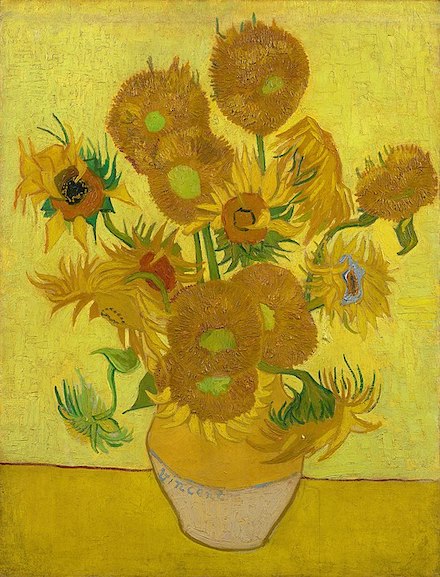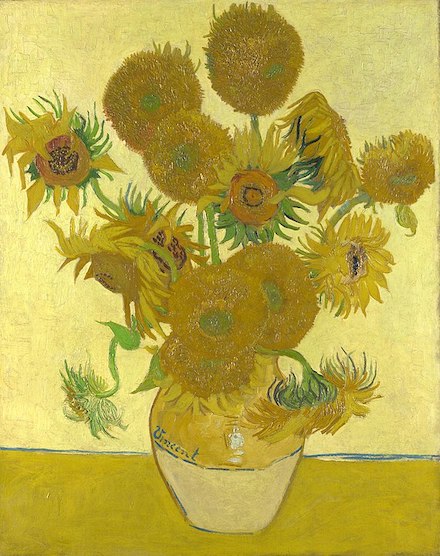
|
|
|
|
|
| Issue 23: | 28 April 2024 |
| Haibun: | 159 words |
By Jacqueline Pearce
Holding On
—After Sunflowers (January 1889) by Vincent van Gogh*
Van Gogh’s Sunflowers are everywhere. First, the print in our basement, on the wall above my mom’s sewing machine table. She added dabs of paint to the flowers, so it would look like a real painting. That was when she was taking an oil painting class at night school. Later, she took a Chinese cooking class. It was the early ’70s, when we didn’t venture far from meat and potatoes, and none of us showed any enthusiasm for her chow mein. Did we discourage her art aspirations, too? After we’d grown up and moved away, she went on a tour of Europe, coming home with photographs of medieval cathedrals, museums, and fields of gold sunflowers. I saw that painting again just last night on a rerun of an old Murder She Wrote, a TV show my mom used to like.
memory loss
holding on to her love
of yellow

Sunflowers (oil on canvas; January, 1889), Version 7, F0458

Sunflowers (oil on canvas; December, 1888), Version 4, F0454
*Publisher’s Note:
Sunflowers (oil on canvas; Version 7, F0458; January, 1889) by Dutch painter Vincent van Gogh (1853-1890) is held by the Van Gogh Museum in Amsterdam. This is the final of seven versions of sunflowers in a vase created by Van Gogh. Version 7 is a copy that the artist made of his fourth version (F0454; December, 1888), which is now held by the National Gallery in London.
With this series, he was experimenting with colors, yellow in particular. For details, see these sources:
The Seven Sunflowers by National Gallery of Australia on Medium (14 December 2020)
Five things you need to know about Van Gogh’s Sunflowers at the Van Gogh Museum in Amsterdam
Sunflowers (Van Gogh series) at Wikipedia
Images above were downloaded on 13 April 2024 from the public domain via the Wikipedia article mentioned above, and appear here with no changes under Creative Commons license CC BY-SA 4.0.
Jacqueline Pearce
is a haiku poet and the author of 12 books for children, including novels, nonfiction, and a collection of short stories for young adults. She was coeditor with Angela Naccarato of The Jade Pond, the Vancouver Haiku Group anthology (2018), and editor of Last Train Home, an international anthology of train-themed haiku, tanka, and rengay (2021). Her haiku have been published in Frogpond, The Heron’s Nest, and Haiku Canada Review, and received honorable mention in the 2010 Vancouver Cherry Blossom Haiku Invitational.
Jacqueline shares haiku and photographs on her blog, wild ink:
https://wildink.wordpress.com/
More info on her children’s books can be found at her website:
https://jacquelinepearce.ca/
More on the Web: By, About, and Beyond
⚡ Haiku in Tashme: The legacy of Sukeo “Sam” Sameshima, an article by Jacqueline Pearce and Jean-Pierre Antonio in British Columbia History (Volume 53, Number 1; Spring 2020), which relates to Jacqueline’s work to translate at least 300 of more than 600 haiku written by Japanese Canadians in the internment camp at Tashme, British Columbia.
| Copyright © 2019-2025 by MacQueen’s Quinterly and by those whose works appear here. | |
| Logo and website designed and built by Clare MacQueen; copyrighted © 2019-2025. | |
|
Data collection, storage, assimilation, or interpretation of this publication, in whole or in part, for the purpose of AI training are expressly forbidden, no exceptions. |
At MacQ, we take your privacy seriously. We do not collect, sell, rent, or exchange your name and email address, or any other information about you, to third parties for marketing purposes. When you contact us, we will use your name and email address only in order to respond to your questions, comments, etc.